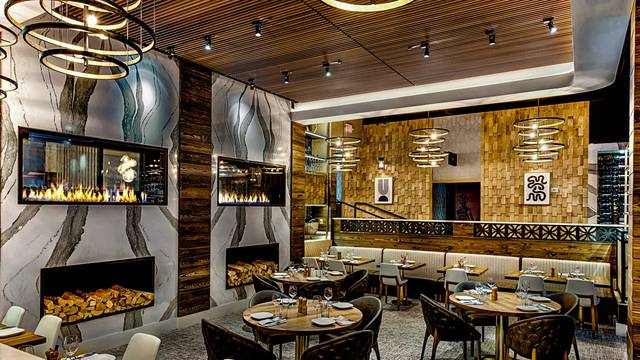Instagrammable Restaurants Islamabad: Picture-Perfect Dining Experiences
Instagrammable Restaurants Islamabad: Picture-Perfect Dining Experiences
Blog Article
Savor Genuine Oriental Cuisine With a Pan-Asian Spin for a Cooking Experience
Embarking on a culinary trip via genuine Oriental cuisine, enhanced with a Pan-Asian spin, supplies an unique possibility to check out the rich tapestry of flavors that specify the area's varied cooking customs. As you consider these luring meals, think about the social stories and historical impacts that form them, each bite offering a tale waiting to be found. asian restaurant isb.

Exploring Pan-Asian Tastes
In the world of worldwide gastronomy, Pan-Asian food sticks out for its impressive variety and the harmonious interaction of tastes from numerous Asian cultures. This cooking method celebrates the unique ingredients and rich traditions found across the continent, producing a tapestry of tastes that is both enjoyable and intriguing. Key to Pan-Asian food is its capacity to stabilize contrasting flavors-- pleasant, salted, spicy, and sour-- while highlighting the quality and top quality of each component.
From the umami-rich soy sauce of Japan to the fiery chili peppers of Thailand, Pan-Asian food provides a considerable palette of flavors. These components are often incorporated in innovative methods, boosting dishes with layers of intricacy. For example, the usage of aromatic herbs such as lemongrass and cilantro, typical in Vietnamese and Thai cuisine, adds a revitalizing illumination to dishes, while the consolidation of coconut milk provides a luscious, abundant texture.
The emphasis on fresh produce and fragrant flavors ensures that each dish is not only a feast for the taste however also for the senses. Pan-Asian cuisine invites diners to begin on a culinary trip, checking out the large and differed landscapes of Eastern gastronomy with every bite.
Fusion Recipes to Try
While Pan-Asian food is commemorated for its standard tastes, the contemporary cooking landscape is significantly welcoming combination dishes that blend these timeless aspects with influences from other regions. This innovative method not only honors the abundant heritage of Eastern cookeries but likewise presents novel taste experiences that appeal to contemporary tastes.
A prime instance of such a fusion dish is the Korean-Mexican taco, where seasoned bulgogi beef is wrapped in a cozy tortilla, topped with kimchi and a zesty gochujang-infused salsa. This combination marries the vibrant, savory tastes of Korea with the vibrant, fresh components of Mexican food. Likewise, sushi burritos have actually gained appeal, integrating the fragile virtuosity of Japanese sushi with the hearty, hand-held comfort of a burrito, commonly including fusion ingredients like tempura shrimp and avocado with a drizzle of wasabi mayo.
One more significant recipe is Thai curry ramen, which infuses the creamy, aromatic flavors of Thai curry into the calming brew of typical Japanese ramen, creating an unified mix that entices the senses. These blend meals extend beyond simple uniqueness; they represent a culinary discussion in between cultures, motivating expedition and technology worldwide of Pan-Asian food.
Important Components and Spices
To truly appreciate Pan-Asian food, one need to understand the vital components and spices that form its foundation. This varied cooking style attracts from an abundant tapestry of Oriental practices, employing a harmonious mix of flavors and appearances.
Fragrant components are pivotal, with garlic, lemongrass, and ginger being ubiquitous throughout numerous Pan-Asian dishes. These ingredients give a great smelling base that improves the complexity of flavors. Flavors such as celebrity anise, cardamom, and cinnamon introduce warmth and character, echoing influences from regions like China and India.

Cooking Strategies and Tips
Mastering the art of Pan-Asian cuisine calls for familiarity with its distinct food preparation techniques, each contributing to the vibrant tapestry of flavors this culinary tradition is commemorated for. Central to these techniques is the stir-fry, a fast food preparation technique that preserves the nutritional integrity and vibrant shades of components. Making use of a wok, the stir-fry technique enables even warmth circulation, important for attaining the characteristic structure and flavor equilibrium of Pan-Asian meals.
One more fundamental strategy is steaming, particularly widespread in Chinese food. This mild approach preserves the all-natural tastes and nutrients of active ingredients, making it perfect for fish and shellfish and vegetables. Dumplings, a cherished staple, frequently gain from steaming, causing soft, delicious appearances.
Grilling, also essential, gives great smoky depths to dishes such as Korean bulgogi or Japanese yakitori (Fine dining experience Islamabad). This technique often includes marinading ingredients, allowing tastes to permeate deeply prior to cooking read more over an open flame or warm plate
Last but not least, understanding the art of balancing tastes-- sweet, sour, salted, bitter, and umami-- is critical. Effectively layering these aspects can boost a meal from average to extraordinary, offering a facility and pleasing culinary experience that embodies the significance of Pan-Asian food.
Dining Experiences Worldwide
Across the globe, Pan-Asian food supplies an exceptional dining experience, celebrated for its rich tapestry of flavors and vibrant presentations. This cooking phenomenon has actually transcended cultural borders, catching the hearts and tastes of food enthusiasts worldwide. In multicultural cities like New York, London, and Sydney, Pan-Asian dining establishments function as fusions where cooking traditions from Thailand, Japan, China, and past assemble, providing restaurants with a diverse mix of dishes that highlight the region's diversity.
The worldwide appeal of Pan-Asian cuisine depends on its capability to supply both credibility and technology. Chefs masterfully marry traditional ingredients such as lemongrass, soy sauce, and miso with modern strategies, causing recipes that are both refreshingly new and acquainted. This combination enables restaurants to start a cooking journey that values heritage while accepting modernity.
Moreover, dining experiences are raised with thoughtfully made atmospheres that show the values of Pan-Asian visual appeals. From minimalist Japanese-inspired interiors to vivid Thai-themed spaces, each restaurant offers a distinct setting that enhances the culinary offerings. Therefore, clients are not simply consuming a meal however partaking in a social experience, making Pan-Asian eating a genuinely global sensation.
Conclusion
The exploration of Pan-Asian food uses an extensive understanding of the detailed interplay of flavors and cooking traditions across Asia. By accepting fusion dishes such as Thai curry ramen and sushi burritos, the cooking trip not just highlights the versatility of standard ingredients yet likewise showcases ingenious contemporary strategies. This gastronomic experience, improved by cooking approaches and essential spices, gives an unique chance to appreciate the multiculturalism and culinary creativity that specify Pan-Asian cuisine on a global scale.
Embarking on a cooking journey via genuine Eastern food, boosted with webpage a Pan-Asian spin, supplies a special chance to check out the rich tapestry of tastes that define the region's diverse culinary traditions.In the realm of worldwide gastronomy, Pan-Asian cuisine stands out for its remarkable variety and the harmonious interplay of flavors from different Eastern societies. Key to Pan-Asian food is its ability to stabilize contrasting flavors-- sweet, salty, spicy, and sour-- while highlighting the freshness check out this site and top quality of each active ingredient.

Report this page